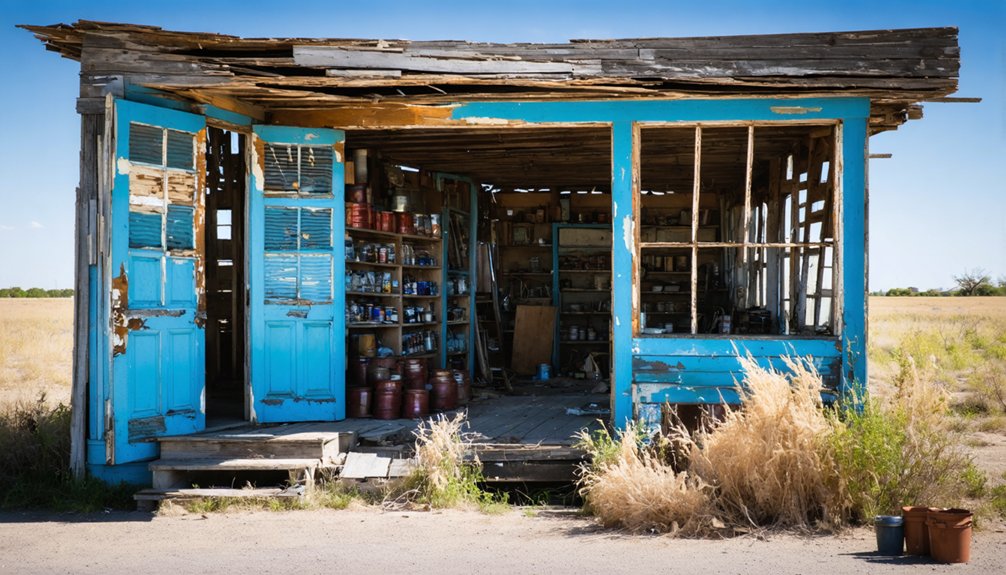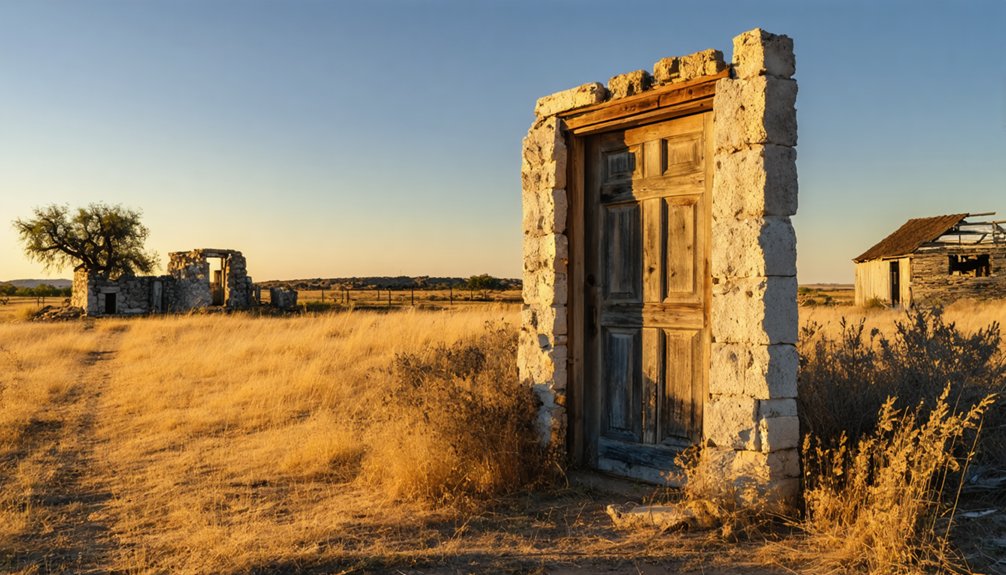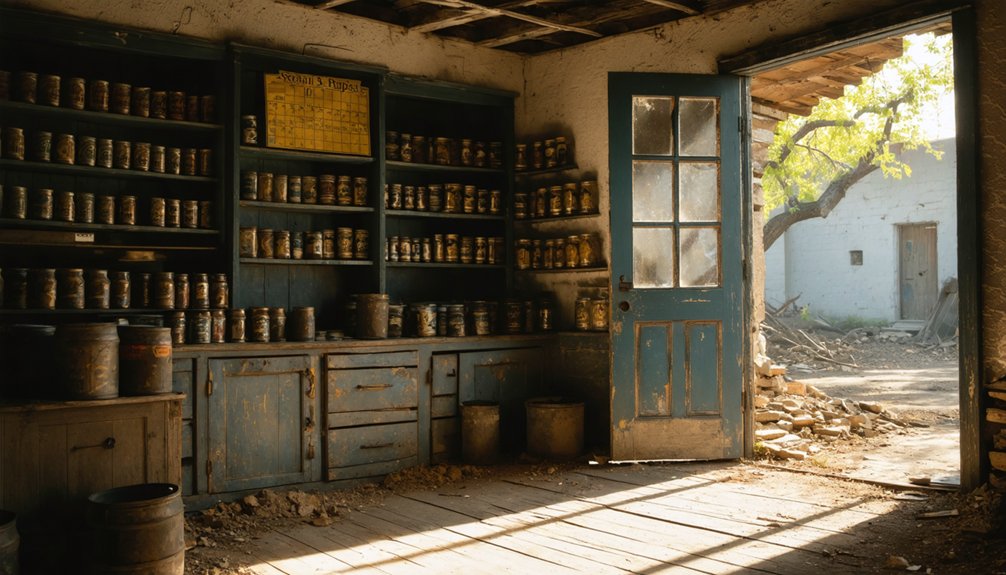You’ll find Caput, Texas in the ghost towns of Gaines County, where it briefly flourished as a post office settlement in William B. Austin’s general store from 1904 to 1906. Located one mile south of present-day Seminole, this frontier community served ranchers and farmers until Seminole’s establishment as the county seat led to its swift decline. The sandy foundations of Caput’s short-lived existence hold fascinating stories of West Texas’s pioneer postal service era.
Key Takeaways
- Caput, Texas was established in 1904 with a post office in William B. Austin’s general store near present-day Seminole.
- The town lost its post office and population to nearby Seminole by 1906, quickly transforming into a ghost town.
- Caput served as an early communication hub for Gaines County ranchers and farmers before Seminole’s emergence.
- The settlement’s rapid decline reflects the economic vulnerability of frontier communities in early 20th-century West Texas.
- No visible structures remain of Caput today, with only historical records preserving its brief existence in Texas history.
The Birth of a Frontier Post Office
While frontier settlements were expanding across West Texas in the early 1900s, the Caput Post Office emerged as a essential communication hub on December 19, 1904.
You’ll find the roots of this frontier communication outpost in William B. Austin‘s general store, located about a mile south of what’s now Seminole, Texas.
Austin, serving as the first postmaster, established this significant link to the outside world during a time of rapid postal evolution across Texas. His store became the area’s lifeline for mail service, representing the push to connect isolated frontier communities through Rural Free Delivery routes.
Caput’s post office symbolized the untamed spirit of West Texas before the region’s formal organization, operating as the primary postal facility until Seminole’s establishment changed the landscape of local mail service. When the community was platted in 1906, lots went on sale to establish what would become a thriving settlement.
Life in Early Gaines County
If you’d lived in early Gaines County, you’d have experienced the hardships of frontier postal service, with mail deliveries requiring arduous trips across sandy terrain to reach scattered homesteads and ranches.
Your daily life would’ve centered around basic survival needs, including hauling lumber from distant towns like Stanton or Big Spring for home construction, and relying on windmills to access scarce water resources.
You’d have found yourself part of a growing community of ranchers, farmers, and Hispanic workers who gradually established permanent settlements despite the challenging semi-arid climate and limited infrastructure. The county was named after James Gaines, a prominent figure who signed the Texas Declaration of Independence.
The area’s early days saw six major ranches operating across the county, with the agricultural census of 1900 recording over 16,000 head of cattle.
Pioneer Postal Services
As settlers established roots in early Gaines County, the 1905 opening of Caput’s post office by W.B. Austin marked an essential step in pioneer postal communication.
You’d find this first post office about a mile south of present-day Seminole, housed within Austin’s store, where it served as a crucial hub for community connections and commerce.
You’ll appreciate how this postal point linked isolated homesteaders to the wider world, enabling important correspondence and news distribution through the Seminole Sentinel.
Operating under challenging frontier conditions, mail carriers braved harsh weather and rough terrain to deliver by horseback and wagon, much like the early El Camino Real routes established by Spanish settlers.
When Seminole became the county seat in 1906, postal operations shifted there, but Caput’s pioneering postal service had already laid the groundwork for the area’s development.
The Texas History Collection provided valuable documentation of these early postal developments, preserving the stories of Gaines County’s pioneering communication systems.
Daily Community Life
Life in early Gaines County centered around farming and ranching, where you’d find European-descended pioneers working alongside Hispanic laborers to build the region’s agricultural foundation.
You’d trade at general stores like W. B. Austin’s, while bartering with neighbors helped sustain daily needs in the sparse settlement. Similar to abandoned Helena, the town experienced a dramatic decline when the railroad bypassed the settlement.
Your social life would revolve around community gatherings and religious celebrations at the Methodist and Baptist churches. Medieval scholars note that such community gatherings often centered around the caput baroniae concept of a main settlement serving as the focal point for local activities.
You’d attend shared Sunday school services that brought together folks across denominations.
The local schools, starting with the two-story building in 1906, served as both educational centers and meeting places.
In these early days, you’d find a close-knit community where church buildings doubled as social venues, and shared meals strengthened bonds between settlers.
The Rise of Rival Seminole
You’ll find that Seminole’s strategic location, chosen by New York investors in 1905, quickly overshadowed Caput’s earlier settlement through rapid infrastructure development.
Within just one year, Seminole boasted a wooden courthouse, multiple churches, and two banks – the Seminole National Bank and First State Bank – while drawing merchants away from Caput. Like Thurber’s transition from black diamond mining, Caput’s economy struggled to adapt to changing market conditions. Like many of the 511 ghost towns scattered across Texas, Caput’s population dwindled as economic opportunities shifted elsewhere.
The new town’s position at major highway intersections, combined with substantial commercial investment, transformed Seminole into Gaines County’s economic powerhouse by 1906, effectively sealing Caput’s fate.
Strategic Town Site Selection
While Caput initially secured a promising location in Gaines County’s agricultural expansion zone, the town’s strategic positioning couldn’t compete with the emerging settlement of Seminole around 1905.
Settlement patterns shifted dramatically as Seminole’s superior location offered better access to crucial transportation routes and trade networks. You’ll find that community dynamics transformed rapidly when businesses and residents recognized Seminole’s advantages for long-term growth.
While Caput had basic agricultural potential and enough land for essential infrastructure, Seminole’s site provided stronger connectivity to emerging railroad lines and regional markets. The impact of economic changes ultimately sealed Caput’s fate, mirroring the decline of many Texas ghost towns.
The rival town’s location also proved more attractive for county-level services and administrative functions, leading to Caput’s swift decline as settlers and commerce gravitated toward the more strategically positioned Seminole.
Infrastructure Investment Shifts
The stark difference in infrastructure investment between Caput and Seminole became evident as early as the 1920s, when the Greater Seminole oilfield discoveries sparked unprecedented development.
You’ll find that Seminole’s infrastructure evolution accelerated rapidly as the town attracted over 20,000 oilfield workers, necessitating expanded rail access, housing, and utilities.
While Caput experienced community decline, Seminole’s growth continued through strategic investments.
The town secured a $110 million bond in 2007 for extensive building projects, modernized its educational facilities, and pioneered a $1.625 million wind-powered water desalination project.
These infrastructure commitments solidified Seminole’s position as the county seat, drawing businesses and residents away from smaller settlements like Caput through superior public services and economic opportunities.
Economic Power Transfer
As oil discoveries transformed Gaines County’s economic landscape in 1935, Seminole emerged as the region’s dominant commercial force through the massive Seminole Pool find.
You’ll find that this economic transformation shifted power away from traditional agricultural landowners, as Humble Oil’s massive 100,000-acre lease drove land values from 50 cents to $10 per acre.
While Caput’s farming community struggled with the harsh realities of the Dust Bowl, Seminole’s community resilience shone through as it embraced oil industry growth and diversification.
By 1940, the region’s population had swelled to 8,136, with many former farmers abandoning their eroded fields for oil-related opportunities.
Seminole’s strategic investment in business development and infrastructure created a new economic hierarchy, where oil companies and entrepreneurs replaced the old agricultural establishment.
A Town’s Swift Decline

Shortly after Caput’s establishment in 1904, neighboring Seminole‘s founding in 1905 triggered an irreversible chain of events that would seal the town’s fate.
You’d have witnessed Caput’s town viability crumble as Seminole rapidly emerged as the dominant regional hub. The economic competition proved too fierce, and within just two years, Caput lost its post office to Seminole.
Without this essential service, the town’s remaining infrastructure and businesses couldn’t sustain themselves. Residents began moving away, particularly to Seminole, where better opportunities awaited.
By early 1906, the writing was on the wall – the once-hopeful settlement had become another casualty of West Texas’s ruthless settlement patterns, where only the strongest towns survived.
Caput’s swift transformation into a ghost town exemplifies how quickly fortunes could change in the early 1900s frontier.
Legacy of a Lost Settlement
Despite its brief existence, Caput’s influence on Gaines County’s development remains significant in Texas frontier history.
You’ll find its lost heritage preserved in historical records, from the Texas State Historical Association to ghost town registries, documenting its role as one of the area’s earliest settlement points.
The town’s community resilience showed through its pioneering post office, established in 1904, which served as a crucial communication hub before Seminole’s rise.
While physical remnants are scarce today, Caput’s story exemplifies the dynamic nature of frontier settlements, where towns could flourish and fade as economic forces shifted.
The site’s documentation in maps, post office records, and county archives guarantees that future generations can understand its contribution to West Texas’s developmental narrative.
Historical Significance in West Texas

When Caput established its post office in December 1904, it marked a pivotal moment in West Texas’s territorial development. You’ll find that this small settlement embodied the region’s dynamic settlement patterns, where communities rose and fell with striking speed.
Caput’s brief existence reflects broader cultural influences that shaped West Texas in the early 1900s. The town’s rapid decline, prompted by Seminole’s growth and changing economic forces, illustrates how settlement success often hinged on strategic location and economic sustainability.
You can trace the impact of regional shifts through Caput’s story, from its hopeful establishment to its merger with Seminole’s post office just thirteen months later. The town’s fate mirrors countless other communities that vanished as West Texas evolved from scattered settlements into more organized population centers.
Traces and Memories
As time has erased most physical evidence of Caput’s existence, you’ll find few tangible remnants of this short-lived West Texas settlement today.
Beyond faint foundations that may lie hidden beneath the soil, virtually nothing marks the spot where this community once stood near modern-day Seminole.
Time and earth have conspired to erase all traces, leaving only whispers of foundations beneath the Texas soil.
The rural remoteness of Caput’s former location reflects its brief history, which centered around a post office that operated for just over a year between 1904 and 1906.
While local historians and genealogical societies preserve some records, the town’s memory lives on primarily through its inclusion in ghost town compilations and historical association publications.
You won’t find any official markers or preserved structures – just open country that quietly holds the story of another vanished Texas community.
Lessons From a Vanished Community

Through Caput’s swift rise and fall, you’ll find a compelling case study of how early Texas settlements could vanish almost overnight. The town’s brief existence from 1904 to 1906 reveals harsh truths about economic vulnerability in frontier communities.
You can trace Caput’s demise to Seminole’s emergence just a mile away, which quickly drained the smaller settlement’s energy.
The lessons are clear: community resilience depends on securing crucial infrastructure and diversified economic foundations. When Caput lost its post office to Seminole in 1906, it lost its anchor institution.
Without key services or county seat status, even established towns could fade into obscurity. Caput’s story serves as a stark reminder that Texas frontier settlements lived or died by their ability to attract and retain essential services and commerce.
Frequently Asked Questions
Who Was the First Postmaster of Caput?
William B. Austin’s appointment as your first postmaster marked Caput’s postal history in 1904. He’d manage postmaster duties briefly before the town’s decline, as nearby Seminole’s growth overshadowed your frontier community.
What Native American Tribes Originally Inhabited the Caput Area?
You’ll find that Coahuiltecan Native Tribes primarily inhabited the area, living as hunter-gatherers across south Texas shrublands, while leaving significant cultural heritage through their traditional seasonal migration patterns.
Were There Any Notable Crimes or Lawlessness in Caput?
Like a dusty, empty jail cell, you won’t find documented crime history in Caput. Records show no evidence of lawlessness or law enforcement challenges during its brief existence before 1906.
What Was the Maximum Population of Caput During Its Existence?
You’ll find historical records don’t document Caput’s exact peak population, but based on population trends of similar Texas ghost towns during that era, it likely maxed out between 150-750 residents.
Did Any Famous Pioneers or Historical Figures Pass Through Caput?
Even if a million pioneers roamed Texas, you won’t find records of any famous historical figures visiting Caput. Its brief existence and limited historical significance left no documented visits by notable personalities.
References
- https://en.wikipedia.org/wiki/Caput
- https://www.county.org/county-magazine-articles/summer-2025/ghost-towns
- https://texashighways.com/travel-news/four-texas-ghost-towns/
- https://www.wikiwand.com/en/articles/Caput
- https://en.wikipedia.org/wiki/List_of_ghost_towns_in_Texas
- https://www.txgenwebcounties.net/gaines/Communities_and_Towns/caput.htm
- https://www.tshaonline.org/handbook/entries/seminole-tx
- https://www.tshaonline.org/handbook/entries/caput-tx
- https://www.texasescapes.com/TOWNS/Seminole/Seminole_Texas.htm
- https://about.usps.com/who-we-are/postal-history/first-post-offices.pdf



